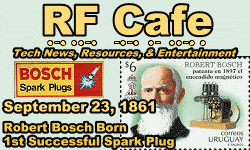|
 September 23 September 23
 1846: German astronomer
Johann Galle
discovered Neptune after only an hour of searching. 1861:
Robert Bosch,
the German engineer and industrialist who was invented the spark plug and magneto,
was born. 1869: Typhoid Mary (Mary Mallon), famous for spreading typhoid fever
in NY, was born. 1877:
Urbain-Jean-Joseph Le Verrier, who calculated the likely position
of Neptune so closely that it took Johan Galle only an hour of search to find, died.
1879: Richard Rhodes invented the
audiophone, the first hearing aid. 1913:
Roland
Garros made the first airplane flight across the Mediterranean Sea. 1930:
Flashbulbs
were patented by Johannes Ostermeier. 1938: A time capsule, to be opened in 6939,
was buried at
World's Fair in New York City. 1960:
Georges Claude,
inventor of the neon light, died. 1962: "The Jetsons"
premiered on ABC-TV, being the first program on the network to be carried in color.
1970: IBM announced the
System 370 computer. 1981: President Reagan announced plans for
Radio Marti to broadcast to the people of Cuba. 1986: The U.S.
Congress the rose as the
national flower. 2002:
Mozilla Firefox
browser was first released as Phoenix. 2018: Britain
Charles K. Kao, "the
father of fiber optic communications," died. 1846: German astronomer
Johann Galle
discovered Neptune after only an hour of searching. 1861:
Robert Bosch,
the German engineer and industrialist who was invented the spark plug and magneto,
was born. 1869: Typhoid Mary (Mary Mallon), famous for spreading typhoid fever
in NY, was born. 1877:
Urbain-Jean-Joseph Le Verrier, who calculated the likely position
of Neptune so closely that it took Johan Galle only an hour of search to find, died.
1879: Richard Rhodes invented the
audiophone, the first hearing aid. 1913:
Roland
Garros made the first airplane flight across the Mediterranean Sea. 1930:
Flashbulbs
were patented by Johannes Ostermeier. 1938: A time capsule, to be opened in 6939,
was buried at
World's Fair in New York City. 1960:
Georges Claude,
inventor of the neon light, died. 1962: "The Jetsons"
premiered on ABC-TV, being the first program on the network to be carried in color.
1970: IBM announced the
System 370 computer. 1981: President Reagan announced plans for
Radio Marti to broadcast to the people of Cuba. 1986: The U.S.
Congress the rose as the
national flower. 2002:
Mozilla Firefox
browser was first released as Phoenix. 2018: Britain
Charles K. Kao, "the
father of fiber optic communications," died.
| Jan
| Feb | Mar |
Apr | May |
Jun | Jul |
Aug | Sep |
Oct | Nov |
Dec |
Note: These
historical tidbits have been collected from various sources, mostly on the Internet.
As detailed in
this article, there
is a lot of wrong information that is repeated hundreds of times because most websites
do not validate with authoritative sources. On RF Cafe, events with
hyperlinks have been verified. Many years ago,
I began commemorating the birthdays of notable people and events with
special RF Cafe logos.
Where available, I like to use images from postage stamps from the country where
the person or event occurred. Images used in the logos are often from open source
websites like Wikipedia, and are specifically credited with a hyperlink back to
the source where possible.
Fair Use laws permit
small samples of copyrighted content.
|
 September 23
September 23